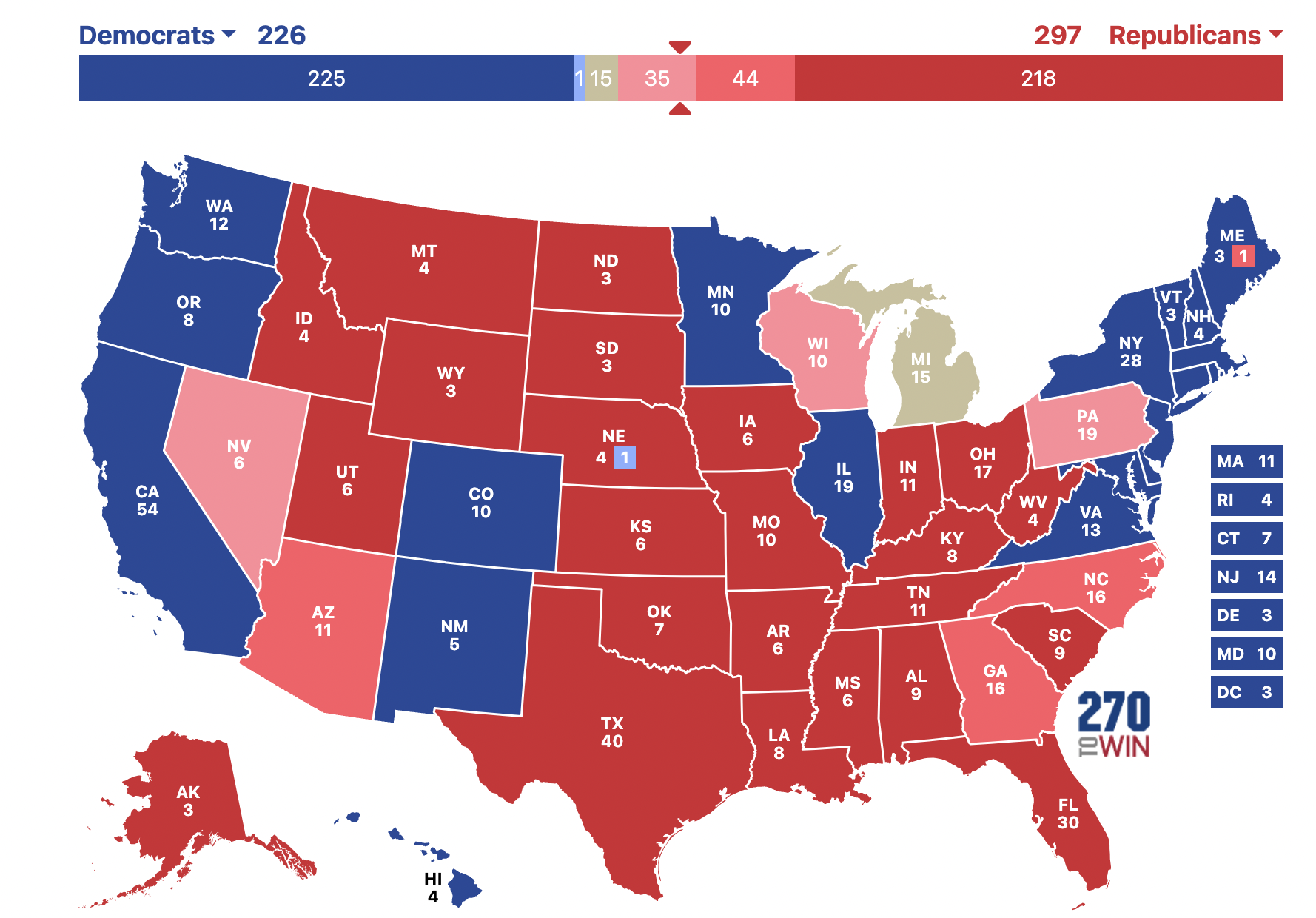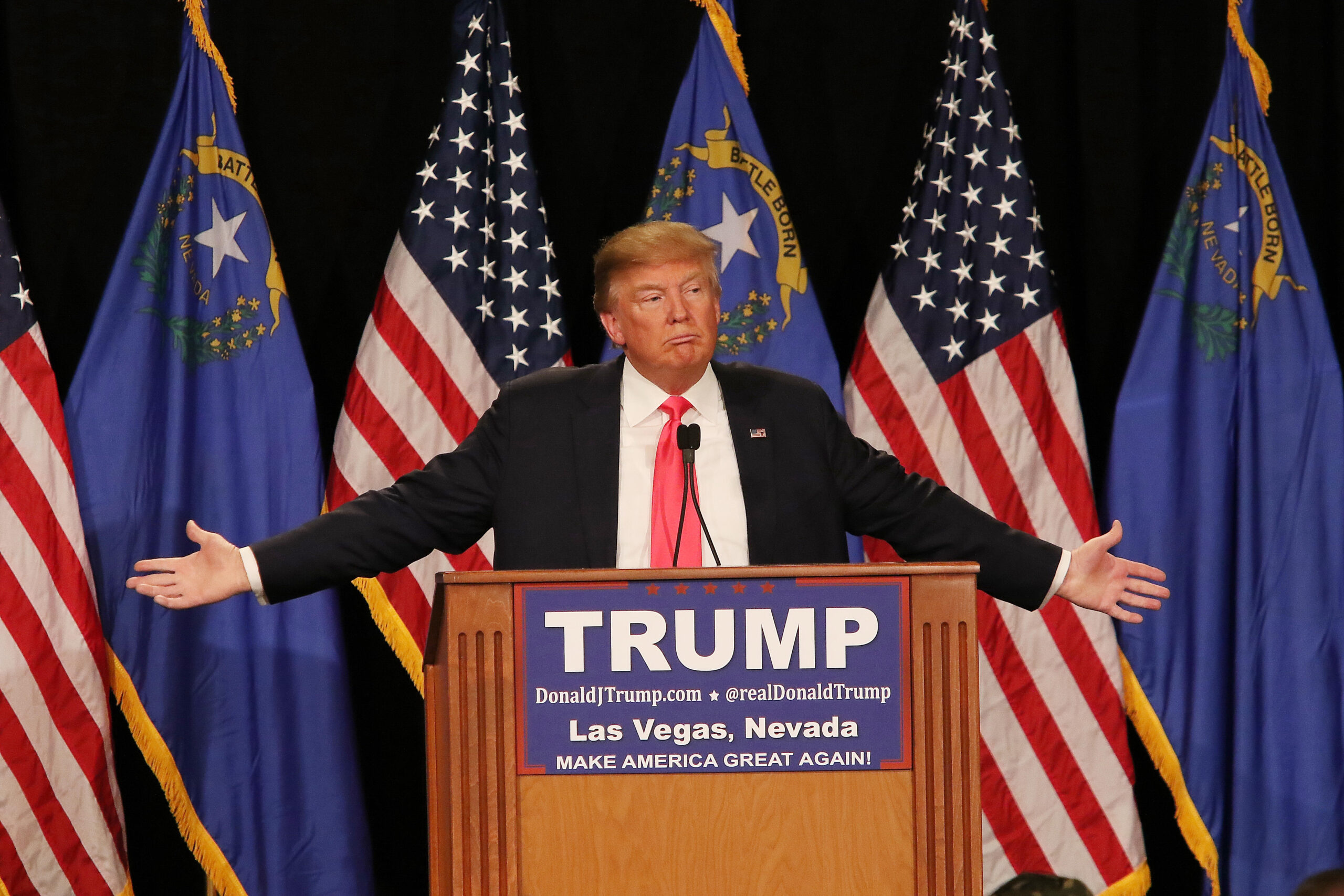Who is leading in the 2024 presidential election predictions? Current data shows Donald Trump as a nearly -200 favorite with an over 60% chance of victory, while Kamala Harris trails as a 3-to-2 underdog.
This article examines the betting odds, national polls, swing state dynamics, and expert forecasts to provide a detailed understanding of the race.
Let's get to the latest presidential election odds with one week to go before the November 5 election.
Key Takeaways
- Donald Trump currently leads presidential election predictions with a 62.18% chance of winning the 2024 election, while Kamala Harris stands at 37.82%, with just seven days until the election.
- Those chances to win are based on election odds of -192 for Trump and +150 for Harris.
- Trump's odds have continued to improve over the past week, as his chances were slightly below 60% just four days ago.
- Key swing states that are crucial for both candidates, particularly Florida and Pennsylvania, are currently in favor of Trump, while one swing state has become a 50/50 toss-up.
Presidential Election Predictions and Odds for the 2024 Election
| Presidential Candidate | Election Odds | Chance to Win |
|---|---|---|
| Donald Trump | -192 | 62.18% |
| Kamala Harris | +150 | 37.82% |
Odds are according to BetMGM UK. The "chance to win the election" percentages are based on implied probabilities with the vigorish removed.
Trump's Betting Odds
Donald Trump stands as the betting favorite in the 2024 presidential election at odds of -192, translating to a 62.18% chance of victory. This marks the highest Trump’s chances have been since Joe Biden exited the race, a time when his odds were even stronger at -225.
Trump’s position is bolstered by his strong performance in key battleground states, where he is currently favored to win. Trump holds a significant advantage in the critical swing states of Arizona, Florida, Georgia, Nevada, North Carolina, Pennsylvania, and Wisconsin. He is a heavy favorite in Florida and Arizona, solid in Georgia and North Carolina, and holds a slight lead in Nevada, Pennsylvania, and Wisconsin.
Trump’s betting odds reached their peak following an assassination attempt in July, with his odds soaring to -400.
Harris' Betting Odds
Kamala Harris has odds of +150, giving her a 37.82% chance of winning the 2024 presidential election.
Her journey in the betting markets has been a rollercoaster. Harris first became a betting favorite over Trump shortly after replacing Joe Biden as the Democratic nominee in early August. Trump reclaimed the lead two weeks later. Harris surpassed him once again during the Harris vs. Trump presidential debate in September, but Trump once again became the betting favorite in the second week of October. Since then, Trump's odds have only gotten better and better.
National Polling Averages
National polling averages serve as a crucial barometer for gauging the potential outcome of the presidential election. Recent national averages indicate that Trump is leading Harris by approximately 8 percentage points at 54% to 46%, suggesting a significant yet surmountable gap for Harris to overcome.
Among Harris supporters, 68% view the economy as a significant factor in their voting decision, while a staggering 93% of Trump supporters consider it crucial. This highlights the economy’s pivotal role in shaping voter preferences.
Understanding polling methodologies is essential for interpreting national polls accurately. Organizations like 538 aggregate data from individual polls, both nationally and in battleground states, to create comprehensive polling averages. The margin of error in these polls indicates the range within which the true value likely falls, providing a measure of reliability.
However, polling organizations face significant challenges in predicting voter turnout, which can affect the accuracy of their results. Accurate methodologies are crucial for understanding how different polling data can predict election outcomes, highlighting the importance of considering these factors in electoral forecasting.
Swing States
Swing states, also known as battleground states, play a pivotal role in determining the outcome of presidential elections. These seven swing states can significantly alter the relationship between the popular vote and electoral votes due to their unique voting rules and demographics. Numerous simulations suggest that Trump has a significant chance of winning a state he previously lost in the 2020 election, highlighting the fluid nature of voter preferences.
As we explore the key swing states, state-by-state analysis, and potential tipping-point states, we’ll uncover the strategic importance of these regions and their impact on the Electoral College.
Key Battleground States
The battleground states for the 2024 presidential election include Arizona, Florida, Georgia, Michigan, Nevada, North Carolina, Pennsylvania, and Wisconsin. These states are critical for both candidates, with polling data indicating a very tight race where no candidate has a decisive lead.
Trump is currently the betting favorite in nearly every one of these key states, reflecting his strategic advantage. The exception is in Michigan, where the election odds suggest essentially a 50/50 coin flip between Harris and Trump.
The outcome in these states will play a crucial role in determining the overall result of the election. Here are the odds to win every state in this year's election.

Odds for Every State
| State | Odds for Trump | Odds for Harris |
|---|---|---|
| Alabama | -10000 | +3300 |
| Alaska | -10000 | +1200 |
| Arizona | -455 | +275 |
| Arkansas | -10000 | +3000 |
| California | +3000 | -10000 |
| Colorado | +1400 | -10000 |
| Connecticut | +2000 | -10000 |
| Delaware | +2500 | -10000 |
| Florida | -2500 | +900 |
| Georgia | -286 | +180 |
| Hawaii | +2500 | -10000 |
| Idaho | -10000 | +2500 |
| Illinois | +2500 | -10000 |
| Indiana | -10000 | +2500 |
| Iowa | -10000 | +1400 |
| Kansas | -10000 | +2500 |
| Kentucky | -10000 | +3000 |
| Louisiana | -10000 | +2500 |
| Maine | +800 | -4000 |
| Maryland | +3300 | -10000 |
| Massachusetts | +3000 | -10000 |
| Michigan | -118 | -118 |
| Minnesota | +700 | -2500 |
| Mississippi | -10000 | +5000 |
| Missouri | -10000 | +2500 |
| Montana | -10000 | +2000 |
| Nebraska | -10000 | +2000 |
| Nevada | -182 | +130 |
| New Hampshire | +500 | -1000 |
| New Jersey | +1400 | -5000 |
| New Mexico | +700 | -2500 |
| New York | +2500 | -10000 |
| North Carolina | -286 | +180 |
| North Dakota | -10000 | +3300 |
| Ohio | -10000 | +1400 |
| Oklahoma | -10000 | +3300 |
| Oregon | +1600 | -10000 |
| Pennsylvania | -137 | +100 |
| Rhode Island | +2500 | -10000 |
| South Carolina | -10000 | +2500 |
| South Dakota | -10000 | +5000 |
| Tennessee | -10000 | +5000 |
| Texas | -10000 | +1400 |
| Utah | -10000 | +2500 |
| Vermont | +5000 | -10000 |
| Virginia | +500 | -1000 |
| Washington | +2000 | -10000 |
| West Virginia | -10000 | +3300 |
| Wisconsin | -133 | +100 |
| Wyoming | -10000 | +5000 |
Chance to Win Each State
| State | Trump's Chance to Win | Harris' Chance to Win |
|---|---|---|
| Alabama | 97.12% | 2.88% |
| Alaska | 92.79% | 7.21% |
| Arizona | 75.46% | 24.64% |
| Arkansas | 96.84% | 3.16% |
| California | 3.16% | 96.84% |
| Colorado | 6.31% | 93.69% |
| Connecticut | 4.59% | 95.41% |
| Delaware | 3.74% | 96.26% |
| Florida | 90.58% | 9.42% |
| Georgia | 67.48% | 32.52% |
| Hawaii | 3.74% | 96.26% |
| Idaho | 96.26% | 3.74% |
| Illinois | 3.74% | 96.26% |
| Indiana | 96.26% | 3.74% |
| Iowa | 93.69% | 6.31% |
| Kansas | 96.26% | 3.74% |
| Kentucky | 96.84% | 3.16% |
| Louisiana | 96.26% | 3.74% |
| Maine | 10.22% | 89.78% |
| Maryland | 2.88% | 97.12% |
| Massachusetts | 3.16% | 96.84% |
| Michigan | 50.00% | 50.00% |
| Minnesota | 11.50% | 88.50% |
| Mississippi | 98.06% | 1.94% |
| Missouri | 96.26% | 3.74% |
| Montana | 95.41% | 4.59% |
| Nebraska | 95.41% | 4.59% |
| Nevada | 59.75% | 40.25% |
| New Hampshire | 15.49% | 84.51% |
| New Jersey | 6.37% | 93.63% |
| New Mexico | 11.50% | 88.50% |
| New York | 3.74% | 96.26% |
| North Carolina | 67.48% | 32.52% |
| North Dakota | 97.12% | 2.88% |
| Ohio | 93.69% | 6.31% |
| Oklahoma | 97.12% | 2.88% |
| Oregon | 5.61% | 94.39% |
| Pennsylvania | 61.81% | 38.19% |
| Rhode Island | 3.74% | 96.26% |
| South Carolina | 96.26% | 3.74% |
| South Dakota | 98.06% | 1.94% |
| Tennessee | 98.06% | 1.94% |
| Texas | 93.69% | 6.31% |
| Utah | 96.26% | 3.74% |
| Vermont | 1.94% | 98.06% |
| Virginia | 15.49% | 84.51% |
| Washington | 4.59% | 95.41% |
| West Virginia | 97.12% | 2.88% |
| Wisconsin | 53.31% | 46.69% |
| Wyoming | 98.06% | 1.94% |
Pathways to Victory
Based on the current election odds and the projected electoral map, Donald Trump has numerous paths to winning the 2024 election. In fact, it's probably more helpful to dissect how Kamala Harris can win the election based on the latest predictions.
If Harris Wins Michigan
Harris could win the election by winning Michigan, where she is currently even-money with Trump, and also winning three of the following five states:
- Arizona (+275 underdog)
- Georgia (+180 underdog)
- North Carolina (180 underdog)
- Pennsylvania (+100 underdog)
- Wisconsin (+100 underdog)
If Harris Loses Michigan
Harris could still win the election if she loses Michigan if she wins:
- Pennsylvania
- Georgia
- And one or more of:
- Arizona
- Wisconsin
- North Carolina
OR
- Pennsylvania
- North Carolina
- And one or more of:
- Arizona
- Georgia
- Wisconsin
If Harris Loses Michigan and Pennsylvania
Harris could still win the election if she loses both Michigan and Pennsylvania if she wins:
- Georgia and North Carolina
- Either:
- Arizona OR Wisconsin AND Nevada
- Arizona AND Wisconsin
Electoral College Projections
To win the presidential election, a candidate must secure 270 electoral votes. The popular vote’s impact culminates in the allocation of 538 electoral votes, primarily determined by the number of congressional representatives each state has. Battleground states hold unpredictable voting patterns, making them vital in determining the election’s outcome.
According to the odds for how many electoral votes each candidate will win, the most likely presidential election prediction is for Trump to win between 300 and 329 electoral votes, with Harris earning between 210 and 239 votes, a 23.13% chance. The next most likely outcome is Trump winning the election with 270 to 299 electoral votes, a 21.24% chance.
The election outcome is likely to depend on just a few thousand voters in key battleground states, highlighting their importance. As we project the distribution of electoral votes and explore pathways to victory for each candidate, the significance of these states becomes even more apparent.
Predicted Electoral Vote Distribution
How Many Electoral Votes Will Donald Trump Win?
| Trump Electoral Votes Won | Odds | Percentage Chance |
|---|---|---|
| 179 or Fewer | +2000 | 3.45% |
| 180-209 | +1000 | 6.58% |
| 210-239 | +500 | 12.06% |
| 240-269 | +325 | 17.03% |
| 270-299 | +225 | 22.27% |
| 300-329 | +200 | 24.13% |
| 330-359 | +650 | 9.65% |
| 360+ | +1400 | 4.83% |
How Many Electoral Votes Will Kamala Harris Win?
| Harris Electoral Votes Won | Odds | Percentage Chance |
|---|---|---|
| 179 or Fewer | +1400 | 4.77% |
| 180-209 | +500 | 11.93% |
| 210-239 | +225 | 22.02% |
| 240-269 | +250 | 20.45% |
| 270-299 | +300 | 17.89% |
| 300-329 | +450 | 13.01% |
| 330-359 | +1000 | 6.51% |
| 360+ | +2000 | 3.41% |
Frequently Asked Questions
What are the current betting odds for the 2024 presidential election?
Currently, Donald Trump has a 62.18% chance of winning the 2024 presidential election, reflected by a betting line of -192, while Kamala Harris has a 37.82% chance with a +150 betting line.
Which are the key swing states for the 2024 election?
The key swing states for the 2024 election are Arizona, Florida, Georgia, Michigan, Nevada, North Carolina, Pennsylvania, and Wisconsin. These states will be crucial in determining the outcome of the election.
How do national polling averages impact election predictions?
National polling averages are essential for forecasting election outcomes as they reflect voter preferences and trends. Relying on these averages helps to make informed predictions about election results.
What are the predicted electoral vote distributions for Harris and Trump?
Predictions indicate that Trump may secure between 300 and 329 electoral votes, whereas Harris is forecasted to receive between 210 and 239 electoral votes.
How can unexpected swing state wins alter the election outcome?
Unexpected swing state wins can dramatically shift the Electoral College balance, ultimately altering the election outcome by changing which candidate gains the necessary electoral votes. Such victories can ignite momentum and influence voter perceptions nationwide.









